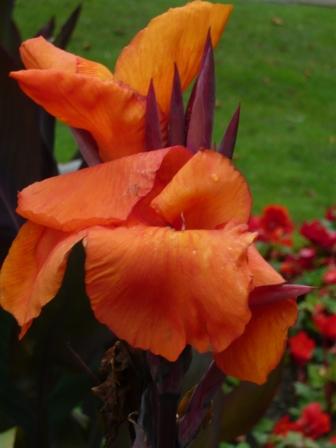Growing Cannas – Facts and Fancy
You don’t need global warming to get a warm glow in your garden if you plant some Canna. The fiery hot flowers and leaves on some Cannas are hard to beat and are worth a place in any passionate garden.
What other plant starts flowering in June and keeps flowering right through until the first frosts. Do not deadhead the flowers at any price as new blooms arise from the center of old ones. They flower in shades of red, orange, pink and yellow often bi-coloured with blotches, spots and streaks. The foliage is also a most attractive feature, and can be shades of purple/bronze, red, green and striped.
Growing Canna
- Rhizomes have to be started into growth in February and you can be certain that if you see a new root, then a new shoot will soon follow. Start them by putting them in a hot place in a poly bag. An airing cupboard is ideal.
- Part fill a 2 liter pot with peat based compost improved with slow release fertilizer and insecticide and lay the rhizome on the compost. If any shoots are growing, place these pointing upwards. Be very careful with any shoots because they break off very easily.
- Fill the pot, affix a label showing the variety and the date of planting. Give the compost a good drenching, and sprinkle a few slug pellets around.
- Place the pot in a warm frost free place. They will grow much quicker if heat is provided.
- They can be planted out in June in sun, shade or preferably semi-shade.
- Cannas prefer a damp soil but can survive some drought conditions. Some varieties grow well in bog gardens.
- Large clumps can be divided in Autumn when the rizomes are stored in a frost free environment. Keep slightly damp.
- Canna are very strong and sturdy and do not require staking. They are generally insect free in the UK.
The Gardener’s Guide to Growing Cannas

Canna or Cannaceae is a single genus that belongs to a group known as the Zingiberales, which include only a few plant families:
Zingiberaceae the gingers
Musaceae the bananas
Strelizeaceae bird of paradise flowers
Marantaeceae prayer plant
All the Zingiberales have leaves that open by unfurling, they usually have large showy leaves, and they all come from the tropics. That explains the big, bold, lush, glorious, tropical leaves and flowers that are found on Cannas.
Some of the individual species include Canna latifolia, liliiflora, pedunculata, flaccida, glauca, amabilis, speciosa, jacobiniflora, stenantha, Patens, plurituberosa or Canna paniculata, discolor, compacta, iridiflora, indica, bangii, coccinea and jaegeriana.
There are three groups of Cannas 12-18 inch high seed raised, Mid height including Canna patens and Warscewiczii and tall varieties that can reach 6 feet tall.
Canna Contacts and Links
http://www.clainescanna.co.uk A canna website, hosted by Malcolm Dalebo in England and his blog http://www.clainescanna.co.uk/APage_News.htm .
http://cannaluver.com/Site/Canna.html An good index of cannas
http://www.canna.pl Poland is strong on Canna. Another good index of cannas
NCCPG National Council for the Conservation of Plants and Gardens.
http://en.wikipedia.org/wiki/Canna_%28plant%29 Canna on Wikipedia
http://www.hartcanna.com/index.html National Plant Collection holders
Ginger up your Cannas
